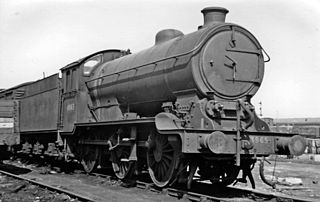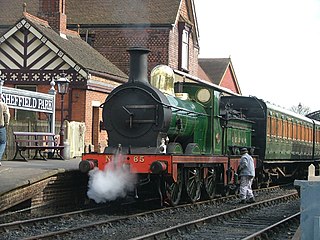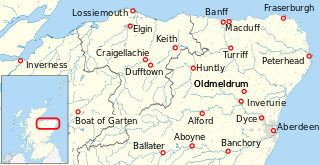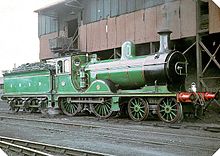John George Robinson CBE, was an English railway engineer, and was chief mechanical engineer of the Great Central Railway from 1900 to 1922.
William Pickersgill was an English railway engineer, and was chief mechanical engineer of the Caledonian Railway from 1914 until Grouping in 1923. He was appointed locomotive superintendent of the Northern Division of the London, Midland and Scottish Railway but retired in 1925. He died in Bournemouth.

The London and North Eastern Railway (LNER) Class J39 was a class of medium powered 0-6-0 steam locomotive designed for mixed-traffic work throughout the former LNER system between London and the north of Scotland.

The Great Central Railway (GCR) Class 9F was a class of 0-6-2T steam locomotive built between 1891 and 1901. From 1923 the locomotives were redesignated Class N5.

The Metropolitan Railway K Class consisted of six 2-6-4T steam locomotives, numbered 111 to 116.
Harry Smith Wainwright was an English railway engineer, and was the Locomotive, Carriage and Wagon Superintendent of the South Eastern and Chatham Railway from 1899 to 1913. He is best known for a series of simple but competent locomotives produced under his direction at the company's Ashford railway works in the early years of the twentieth century. Many of these survived in service until the end of steam traction in Britain in 1968, and are regarded as some of the most elegant designs of the period.

The South Eastern Railway (SER) O Class was a class of 0-6-0 steam locomotive designed for goods work, and were the main goods engines of the SER, and later the South Eastern and Chatham Railway (SECR) for a number of years. However, they were displaced by the more powerful C class locomotives following the amalgamation of the South Eastern Railway and London, Chatham and Dover Railway (LCDR) in 1899. This relegated the class to working on the numerous branch lines in Kent, on both passenger and goods work. They worked most notably on the Kent & East Sussex Railway and East Kent Railway, operating coal trains from the Kent coal fields to London, as well as shunting work at such locations as Shepherds Well, Hoo Junction and Ashford. The majority were withdrawn before the outbreak of the Second World War in 1939, and those that remained were slowly withdrawn from nationalisation onwards.

The M&GN Class C was a class of 4-4-0 steam tender locomotives of the Midland and Great Northern Joint Railway.

Inverurie Locomotive Works was created in 1902 when the Great North of Scotland Railway (GNSR) moved their works from Kittybrewster, in Aberdeen about 15 miles (24 km) to Inverurie.

The Great Central Railway Class 8, known as the London and North Eastern Railway Class B5 following the 1923 Grouping, was a class of fourteen 4-6-0 steam locomotives designed to haul fast goods trains, in particular fish trains.
The Midland Railway Johnson 0-6-0 were a class of locomotives serving Britain's Midland Railway system in the late 19th and early 20th centuries. Between 1875 and 1908 the Midland Railway, under the control of locomotive superintendents Samuel Waite Johnson and Richard Deeley, ordered 935 goods tender engines of 0-6-0 type, both from the railway's own shops at Derby and various external suppliers. Although there were many variations between different batches both as delivered and as successively rebuilt, all 935 can be regarded as a single series, one of the largest classes of engine on Britain's railways. The locomotives served as late as 1964, but none of them now survive.

The LCDR R1 class was a class of 0-4-4T locomotives on the South Eastern and Chatham Railway (SECR), which were based on an existing London, Chatham and Dover Railway (LCDR) design.
Robert Absalom Thom was the final Locomotive, Carriage and Wagon Superintendent of the Lancashire, Derbyshire and East Coast Railway, and became a key figure in the locomotive departments of the company's successors, the Great Central Railway and the London & North Eastern Railway. Thom was born at Aberdeen on 14 June 1873. He attended Robert Gordon's College in Aberdeen, where he received a technical education.

The GER Class B74 was a class of five 0-4-0T steam locomotives designed by Alfred John Hill for the Great Eastern Railway. They all passed to the London and North Eastern Railway at the 1923 grouping and received the LNER classification Y4.
The SECR Q1 class was a class of 0-4-4T steam locomotives of the South Eastern and Chatham Railway. The class was rebuilt from older Stirling Q class locomotives by Harry Wainwright between 1903 and 1917 by fitting the boiler that had been designed for the H class 0-4-4T in 1902–03.
The LCDR T class was a class of 0-6-0T steam locomotives of the London, Chatham and Dover Railway. The class was designed by William Kirtley and introduced in 1879.

The locomotives of the Great North of Scotland Railway were used by the Great North of Scotland Railway to operate its lines in the far north-east of the country. The railway opened in 1854 with just five 2-4-0 steam locomotives, and from 1862 it used 4-4-0 exclusively as the wheel arrangement for its tender locomotives. When it expanded by amalgamation in 1866, it inherited some locomotives from these companies. It purchased most of its locomotives, although building a small number itself, two at its first works at Kittybrewster, and ten later at Inverurie Locomotive Works.

The Great Central Railway (GCR) Class 9A was a class of 0-6-2T steam locomotive built between 1889 and 1892. From 1923 the locomotives were redesignated Class N4.

The London and North Eastern Railway (LNER) D41 class was a type of 4-4-0 steam locomotive inherited from the Great North of Scotland Railway (GNSR). The class consisted of two similar GNSR classes: 'S' and 'T'. The two classes were similar but with detail differences to the boiler.
The LCDR Aeolus class was a class of four 4-4-0 steam locomotives. They were supplied to the London, Chatham and Dover Railway (LCDR) by R. & W. Hawthorn & Co. acting as agents for Robert Stephenson & Co. which built the locomotives, but had subcontracted some components to Hawthorn. They were delivered to the LCDR between September 1860 and April 1861. They were all renewed by William Martley as 2-4-0T at the LCDR's Longhedge works in 1872–73, using components from the original locomotives, including the boilers.













